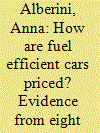|
|
|
Sort Order |
|
|
|
Items / Page
|
|
|
|
|
|
|
| Srl | Item |
| 1 |
ID:
169739


|
|
|
|
|
| Summary/Abstract |
Do consumers value the fuel economy of cars? We examine this question taking advantage of the recent introduction of hybrid and battery-electric vehicles, which promise to reduce the use of fossil fuels in road transport, and hence carbon emissions and dependence on oil imports. The price of these vehicles may however create hurdles to their widespread adoption. Automakers claim that these technologies come with higher production costs. Consumers should be willing to pay a price differential for these cars just equal to the savings in fuel costs—unless their utility depends on considerations beyond car quality, performance and fuel economy.
|
|
|
|
|
|
|
|
|
|
|
|
|
|
|
|
| 2 |
ID:
176868


|
|
|
|
|
| Summary/Abstract |
Despite its importance for policy purposes, evidence about the price elasticity of natural gas demand in the residential sector is very limited and based on inference from situations with modest variation in prices. We focus on a locale and time when price changes were extreme and salient to consumers, namely Ukraine between 2013 and 2017. We exploit the tariff reforms and detailed micro-level household consumption records to assess whether consumers adjust their consumption in response to the rate changes and estimate the price elasticity of the demand for natural gas. To isolate behavior, attention is restricted to those households that made no structural energy-efficiency upgrades to their homes, thus keeping the stock of gas-using capital fixed. We find that households are capable of reducing consumption, even without installing insulation or making any other structural modifications to their homes. The price elasticity is about -0.16. Wealthier households, people living in multifamily buildings, and heavy users have more inelastic demands. Households reduced consumption even when they received government assistance. This, and the fact the demand is inelastic, especially for wealthier households, bode well for tariffs or energy tax schemes where wealthier households subsidize the consumption of the poorer ones.
|
|
|
|
|
|
|
|
|
|
|
|
|
|
|
|
| 3 |
ID:
150022


|
|
|
|
|
| Summary/Abstract |
Price elasticity estimates of residential electricity demand vary widely across the energy economics and policy literature. In this paper, we seek to explain these findings using three nationwide datasets from the U.S. – the American Housing Survey, Forms EIA-861, and the Residential Energy Consumption Survey. We examine the role of the sample period, level of aggregation, use of panel data, use of instrumental variables, and inclusion of housing characteristics and capital stock. Our findings suggest that price elasticities have remained relatively constant over time. Upon splitting our panel datasets into annual cross sections, we do observe a negative relationship between price elasticities and the average price. Whether prices are rising or falling appears to have little effect on our estimates. We also find that aggregating our data can result in both higher and lower price elasticity estimates, depending on the dataset used, and that controlling for unit-level fixed effects with panel data generally results in more inelastic demand functions. Addressing the endogeneity of price and/or measurement error in price with instrumental variables has a small but noticeable effect on the price elasticities. Finally, controlling for housing characteristics and capital stock produces a lower price elasticity.
|
|
|
|
|
|
|
|
|
|
|
|
|
|
|
|
|
|
|
|
|